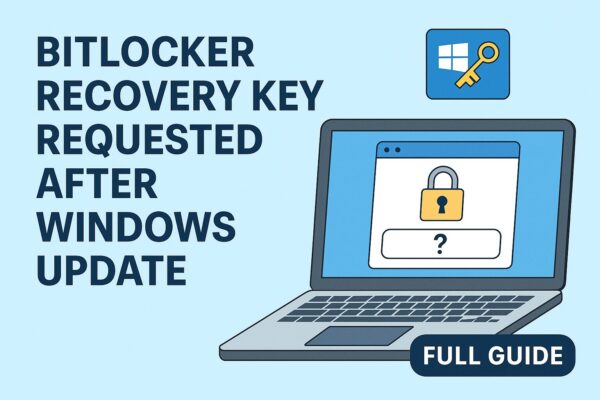
If your Windows PC suddenly asks for a BitLocker recovery key after a restart or update, don’t panic. This guide explains why it happens, where to find the key fast, and what to do if you can’t find it—plus simple prevention steps so it won’t catch you off guard next time.
What is BitLocker (and “Device Encryption”)?
BitLocker is Windows disk encryption that protects your data if a device is lost, stolen, or tampered with.
- On Windows 11 Pro, you’ll see BitLocker.
- On Windows 11 Home, supported models show Device Encryption (not every Home PC supports it—hardware requirements apply).
Either way, your drive is encrypted and a recovery key exists.
Why Windows is Asking for a Recovery Key
BitLocker uses trusted hardware (TPM, Secure Boot, etc.) to verify the device hasn’t changed. If it detects a change—or potential tampering—it asks for the key to confirm it’s still you.
| When it appears | Typical reason |
|---|---|
| After a major Windows update | Boot/TPM measurements changed; re-verification required |
| After BIOS/UEFI or firmware changes | Secure Boot / firmware state changed |
| After hardware changes (SSD/RAM/motherboard) | The system looks “different” to the security chip |
| After multiple sign-in failures / unusual activity | BitLocker enters protective mode |
Seeing the prompt does not mean your PC is broken—it’s a safety feature working as intended.
How to Find Your BitLocker Recovery Key (Fastest Order)
1) Microsoft Account (fastest for personal devices)
- On another device, open:
https://account.microsoft.com/devices/recoverykey - Sign in with the same Microsoft account you use on the locked PC.
- Match the “Key ID” on the blue recovery screen to the same Key ID shown online, then enter the 48-digit key exactly as displayed (hyphens included).
Key ID matters. If you have multiple saved keys, use the entry whose Key ID matches the one shown on the PC. After you sign back in, print the page and write the PC name / date / Key ID on it.
Note: If the PC uses a local account and the key was never backed up online, nothing will appear here.
2) Work/School devices (managed)
If it’s a company or school laptop, the key is often stored by the organization in Microsoft Entra ID (formerly Azure AD) or their management tool (e.g., Intune). Contact your IT admin and provide the Key ID from the recovery screen.
3) Printed or saved copies
Check for:
- A printed page labeled “BitLocker Recovery Key”
- A .txt file on a USB drive (often named like “BitLocker Recovery Key … .txt”)
- A copy in your cloud storage (OneDrive, etc.)
After you regain access: Keep the key in at least two places (Microsoft account + USB + printed copy).
If You Have the Key but Windows Still Won’t Boot
Sometimes you enter the correct key, but Windows keeps looping or fails to start (often after firmware changes). Try in this order:
A) Automatic Repair (WinRE)
- Force power off 2–3 times during the spinning dots to trigger Windows Recovery Environment (WinRE).
- Go to Troubleshoot → Advanced options → Startup Repair.
B) Safe Mode (if available)
- Troubleshoot → Advanced options → Startup Settings → Restart.
- Choose 4) Enable Safe Mode.
- From Safe Mode you can uninstall recent updates or temporarily pause protection:
- Command Prompt (Admin):
manage-bde -protectors -disable C:
(After fixing the issue)manage-bde -protectors -enable C:
- Command Prompt (Admin):
C) Rebuild boot files (UEFI/GPT-friendly)
- Boot from a Windows installation USB → Repair your computer → Troubleshoot → Advanced options → Command Prompt.
- Rebuild boot files:
bcdboot C:\Windows /l en-US - Then repair system files (adjust drive letters if needed):
sfc /scannow /offbootdir=C:\ /offwindir=C:\Windows DISM /Image:C:\ /Cleanup-Image /RestoreHealth
Why not bootrec /fixboot? On modern UEFI/GPT systems it often returns “Access is denied.” bcdboot is the safer first choice.
What If You Can’t Find the Key?
Without the recovery key, the encrypted data cannot be unlocked. You can still reuse the device after a reset, but all data on the drive will be lost.
How to Reset (Factory Reset) Windows
⚠ Important: This erases your files, apps, and settings.
- Start → Settings → System → Recovery
- Reset this PC → Remove everything (recommended when BitLocker issues are involved)
- Choose Cloud download (more reliable) or Local reinstall
- Click Reset and wait for completion
Prevent Being Asked for the Key Next Time
- Pause protection before hardware/firmware changes.
Open Terminal (Admin):manage-bde -protectors -disable C:Perform the change (BIOS/UEFI update, RAM/SSD swap), then:manage-bde -protectors -enable C:PowerShell alternative:Suspend-BitLocker -MountPoint "C:" -RebootCount 1 Resume-BitLocker -MountPoint "C:" - Keep multiple copies of your recovery key (account + USB + print).
- Back up important data before big Windows updates.
- Know where to manage it:
- Windows 11 Home (supported models): Settings → Privacy & Security → Device Encryption
- Windows 11 Pro: Control Panel → BitLocker Drive Encryption (or Settings paths above)
FAQ
Can Microsoft Support unlock my drive without the key?
No. Neither Microsoft nor the device maker can decrypt data without your recovery key.
Is it safe to turn BitLocker off?
You can decrypt with manage-bde -off C:, but you’ll lose data-at-rest protection while it runs. Keep AC power connected and avoid shutdown until it completes.
I use a local account—could the key still be online?
Only if you (or your organization) explicitly saved it to a Microsoft account or management system. Otherwise, check printouts/USB/cloud.
Quick Decision Table
| Scenario | Do this |
|---|---|
| Personal PC with Microsoft account | Check the online recovery portal; match Key ID, enter the 48-digit key |
| Work/School device | Ask IT (key stored in Entra ID/Intune); provide Key ID |
| You printed/saved it before | Search papers/USB/cloud for a .txt recovery key |
| Key found but boot keeps failing | Use WinRE → Startup Repair → then bcdboot + SFC/DISM |
| No key anywhere | Factory reset (data erased, device reusable) |
Before You Go
If this guide helped, bookmark it and store your recovery key in at least two places. One minute now can save hours of stress later.
Related reads
▶ How to Fix “A Required File Is Missing or Corrupt” Error in Windows
▶ Safe to Delete Windows Update Files?
▶ What to Do When Windows Gets Stuck at “Installing Application”


![Windows File Explorer Tips: Stop Opening Every Folder and Use These Tricks Instead [2025]](https://kimiyoya.com/wp-content/uploads/2025/07/3293A3DF-E156-4904-B08E-D80236BC5C0A-375x250.jpg)